For Romans who can't win and Gallics who are bored
The other day, I played Caesar: Rome vs. Gaul with William Walker by Vassal email match for a month and a half. He has played against players all over the world and published detailed strategic research about this game. So to speak, he is the person who gathered the world's wisdom about Caesar. And I've played Caesar over a dozen times, and Romans are ahead.
At BGG, many people feel it difficult to win as Romans. But if I play against a excellent player like him and can win as Romans without good luck, it is a strong proof that Romans can fight more than equal. Because I've written the strategy, choices, and readings in detail, if you think Romans can't win or Gallics are bored, be sure to check with your own eyes to see if your thought is correct. William Walker as Gallics and I as Romans.
Explanation of the figure
Red line : Roman army movement route (thin line : avoid)
Blue line : Gallic army movement route (thin line : avoid)
Green line : Gallic army Spring muster route
Red circle : removed / converted Roman IM
Blue circle : removed / converted Gallic IM
Blue square : removed fortified town
Yellow circle / square : important placement (winter, event, etc.)
Lightning : siege
Star : battle
Turn 1, Caesar sieged consecutively from Parisii to Suessiones, Parisii surrendered and Suessiones was defeated. At the same time, legate conquered the Caesar's pass. But Romans were forestalled about "German Migration" both had, and lost an action.
On the other hand, Gallics were going to place IMs on the outer edge of Gaul, and the Santones removed Roman IM in Aquitania with forced march. This may seem modest, but it is blocking the invasion of Britannia and Germania, and preventing Caesar removing or converting nearby Gallic IMs on the way of attacking the central tribes.
And in the 6th round, after Caesar had finished siege for the second tribe, Gallics used "You may believe what you wish" as APs and placed IMs. It's an important card that can cancel opponent's card, so it should be normally kept until last. therefore, I didn't believe that the strong player like him would put it out without thought in such non-urgent time . "What does this mean?", Romans thought.
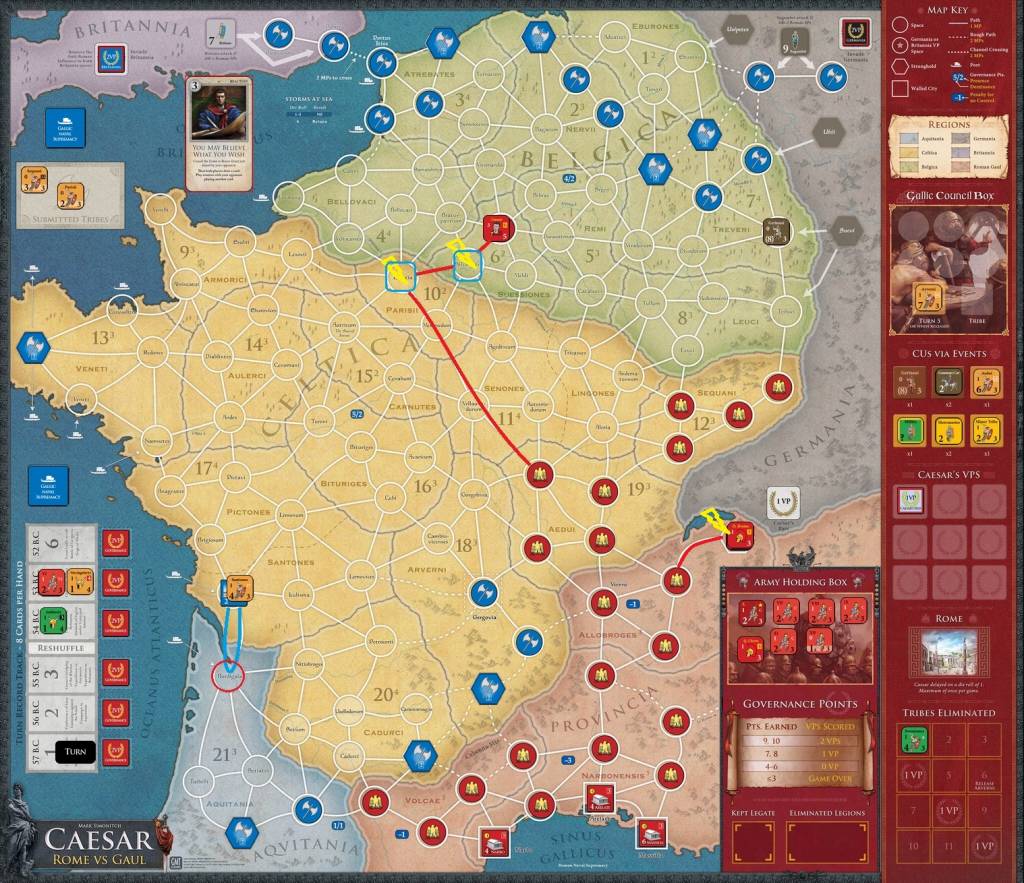
Round6
"He surely has a stronger card. Probably "Senate outraged over Caesar's brutality"." Romans had "Veni Vidi Vici", but didn't know if Gallics have the two cards that can cancel it. Therefore, Romans hadn't used it so far. But now, it's time to put it out.
"I take a chance!" Caesar advanced to Atrebates, spread his army, and converted all three Gallic IMs. He Removed the hindrance of Britannia invasion. However, on this opportunity Caesar left, Gallics broke Roman control of Allobroges by "Unrest spreads", and placed an IM in Carnutes.
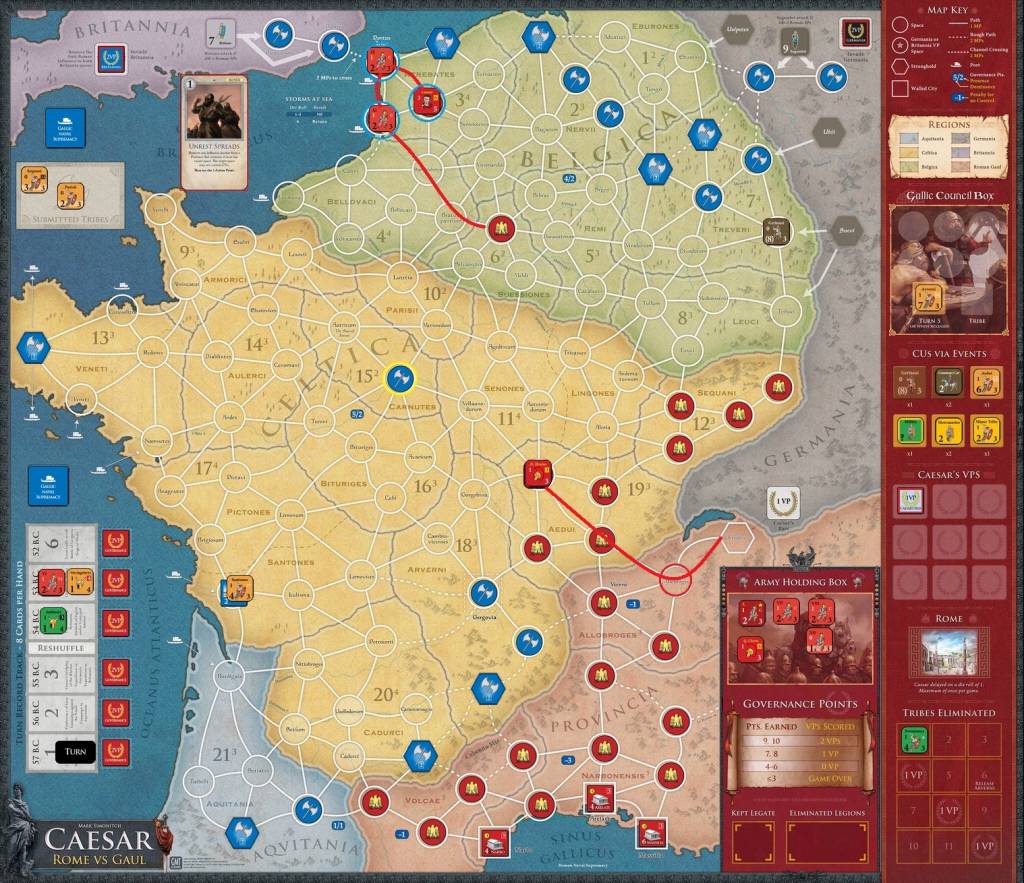
Round7
This action looks casual, but is dangerous in fact. If Romans act thoughtlessly, they may suddenly lose in one turn. Is Gallic last card really the Senate? Or, is it "3" card or other useful event, and the previous card a bluff? Can Romans manage any Gallic action? I was very worried.
At this time, cards remained in Roman hand were "Roman bribes" and "The reach of Rome". First of all, in order to prepare for the Senate, Romans should leave "Roman bribes", which is "1" value. And what is the most effective with the two actions of "The reach of Rome"? Currently, Belgica can't be dominated, so if Romans control Celtica and secure the Provincia control, they will take 1 VP in governance. Therefore, one IM is in Allobroges, and is the other in Carnutes? Normally, Romans cannot place an IM in Gaul without a legion or an adjacent IM. But "The reach of Rome" is exception, and the IM can be placed there.
Hereby, if Gallic last card is the Senate, as expected, Gallics will take "Roman bribes" and place only one IM, and ending without increasing control. If it is "2" or "3" card, Gallics can gain one control, but Romans can use the bribes to take control of Carnutes and regain dominance of Celtica. It is the same even if an IM is flipped by diplomacy. This should be fine!
Sure enough, the gallic last card was the Senate. Gallics controlled Aquitania and Romans controlled Atrebates, and the strategy phase ended. "The reach of Rome", which had never been useful, helped Romans for the first time. Then, Roman legions spread adjoiningly each other for winter camp, and placed 8 IMs to establish three control: Bellovaci, Suessiones, and Parisii.
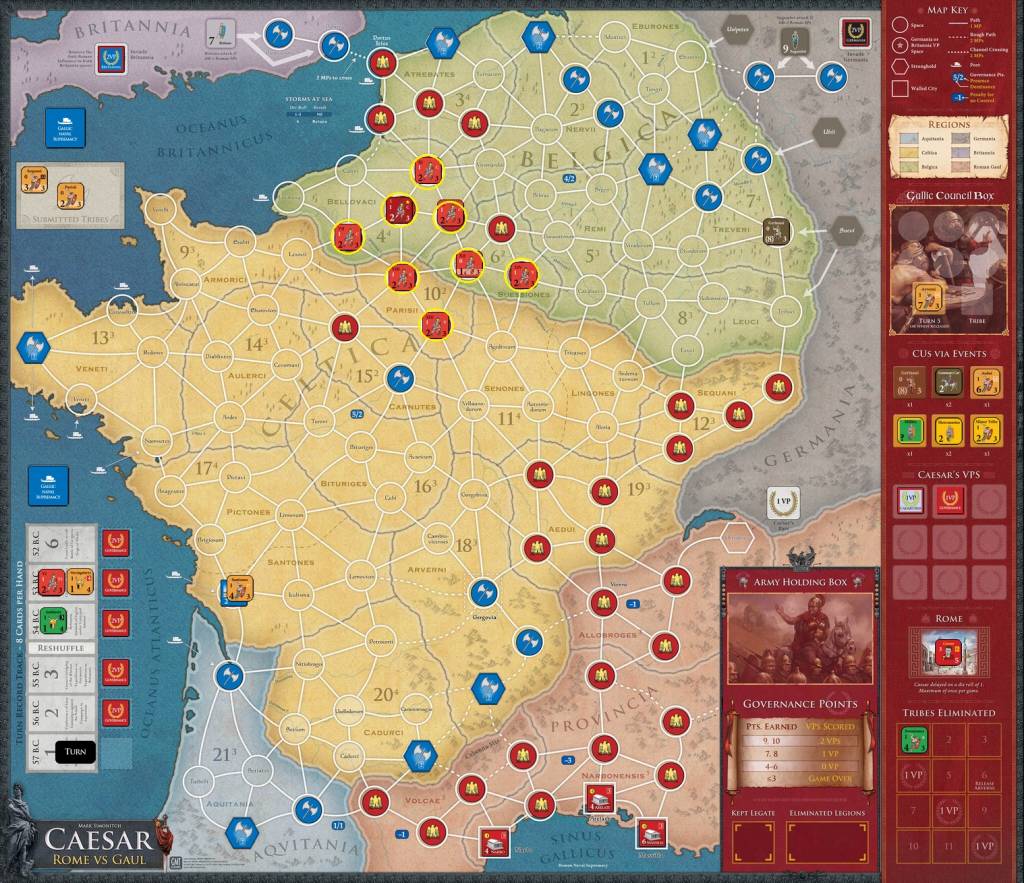
Winter
Very distressing and hard progress from the first turn. What will happen next year?
Turn 2, all Gallic tribes appeared were in Belgica. Caesar wanted to go to Britannia. But in anticipation of that, Gallics advanced the Santones to a space adjacent to Provincia in spring muster, revived the Sequani by local raids of the Leuci, and removed an IM in Carnutes by "Incite through sedition & violence", hereby threatened behind Romans.
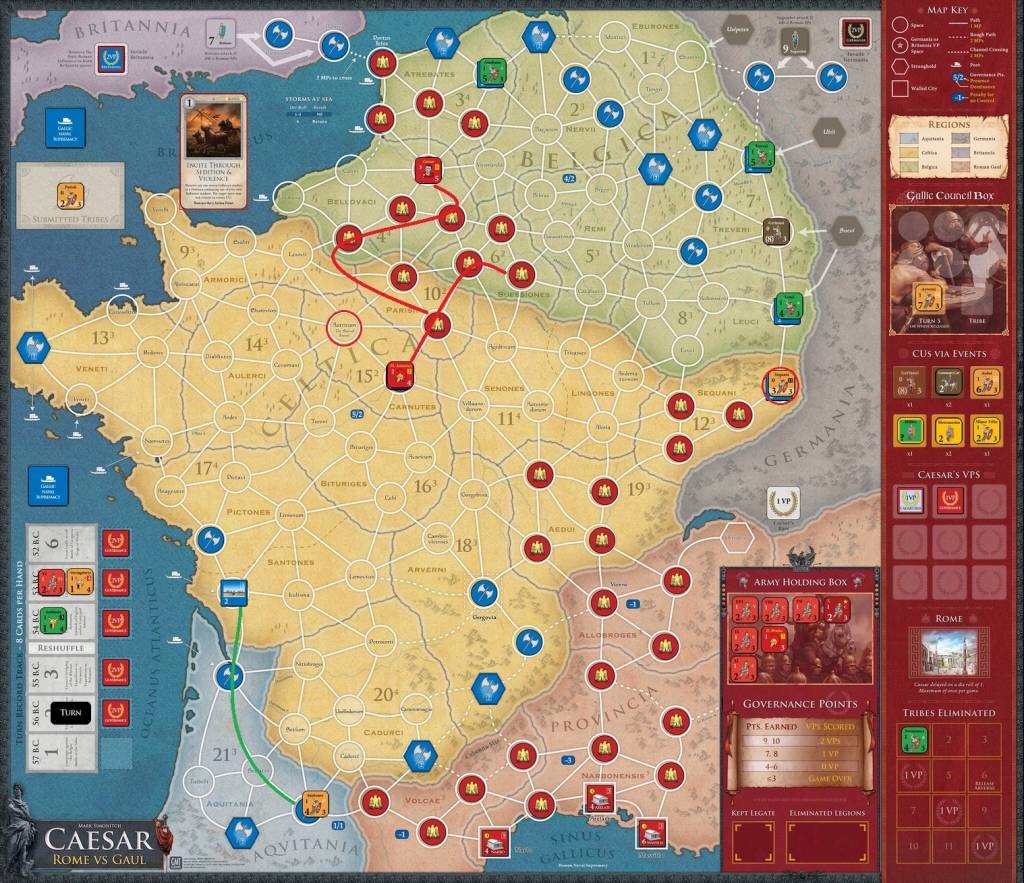
Round2
Caesar didn't hope to be involved in them, so he left pacifying Carnutes to Antonius, and first headed to siege the Atrebates, who interfered with the Britannia invasion. However, the first siege was ineffective with roll 3, and the siege eventually took until round 4. It was also hard to not be able to recruit the two German auxiliary cavalry that came this turn, since Gallics had blocked all roads to Germania.
Gallics were steadily increasing IMs to Celtica, thereby, if Caesar advances to Britannia, it may go meaningless to lose governance VPs. Romans thought so. Even if the same VP is gained in governance and quest, governance that IMs continue to remain is far more valuable than quest which take only one-time VP.
Caesar gave up the invasion of Britannia and proceeded to convert two IMs in Nervii with "A friend of Rome". And Antonius was about to attack the empty Santones fortified town next, but Gallics placed an IM adjacent to there just before. "I see, if Antonius attacks according to plan, IMs will be placed behind him, and he will be attacked with Gallic local support and without a path to retreat. Antonius gave up the attack due to Gallic clever operation, and headed to Arverni for breaking Gallic control.
At 7th round in such situation, Gallics turned over an IM in Volcae by diplomacy. "Hmm, what's this? Double aiming Celtica and Volcae?" If Romans control both Belgica and Celtica, it will be 2VP by 9 governance points, but if the control of Volcae is broken, it will be reduced to 1VP, and if Celtica, 0VP. Can Romans prevent this?
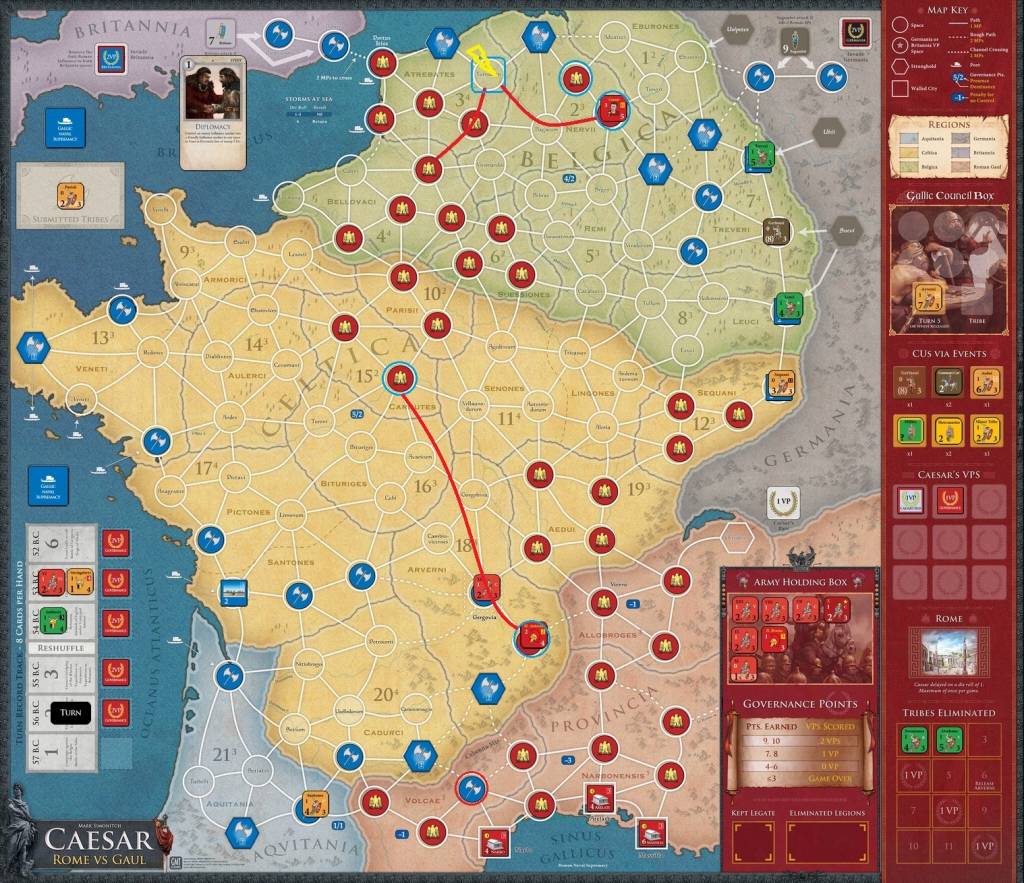
Round7
The remaining Roman cards are "2" and "3" of the Gallic event. Since Gallics used diplomacy here, they may have "Gaul of the long-hairs" or "3" card, otherwise at least "2", so expected. Gallics can take control of Arverni or Cadurci, or else, by the Santones invasion or "Gaul of the long-hairs", can break the control of Volcae.
Romans thought about variations, but they couldn't find a way to prevent them 100%. Then Romans should dominate Celtica 100% at least, and be able to control Volcae as possible. It was too difficult and not confident, however Romans sent Antonius to Volcae, and converted an IM in Arverni, by "2" card. Hereby, with "3" card left, the control of Arverni can be regained no matter what Gallics do, and Volcae maybe regained if Antonius fight with his ability at worst. Romans thought.
And the last card came out from Gallics was "Alesia". Upon seeing the movement of Romans, Gallics judged that they can't break dominance or control. Instead of them, Gallics strengthened fortified town in Sequani to avoid auto submission, and placed IMs in positions they can cut Caesar's supply path. Then, Romans had completed strategy phase by removing and converting Gallic three IMs in Volcae and Belgica. And in winter, Romans place IMs, 5 in Belgica and 1 in Volcae.
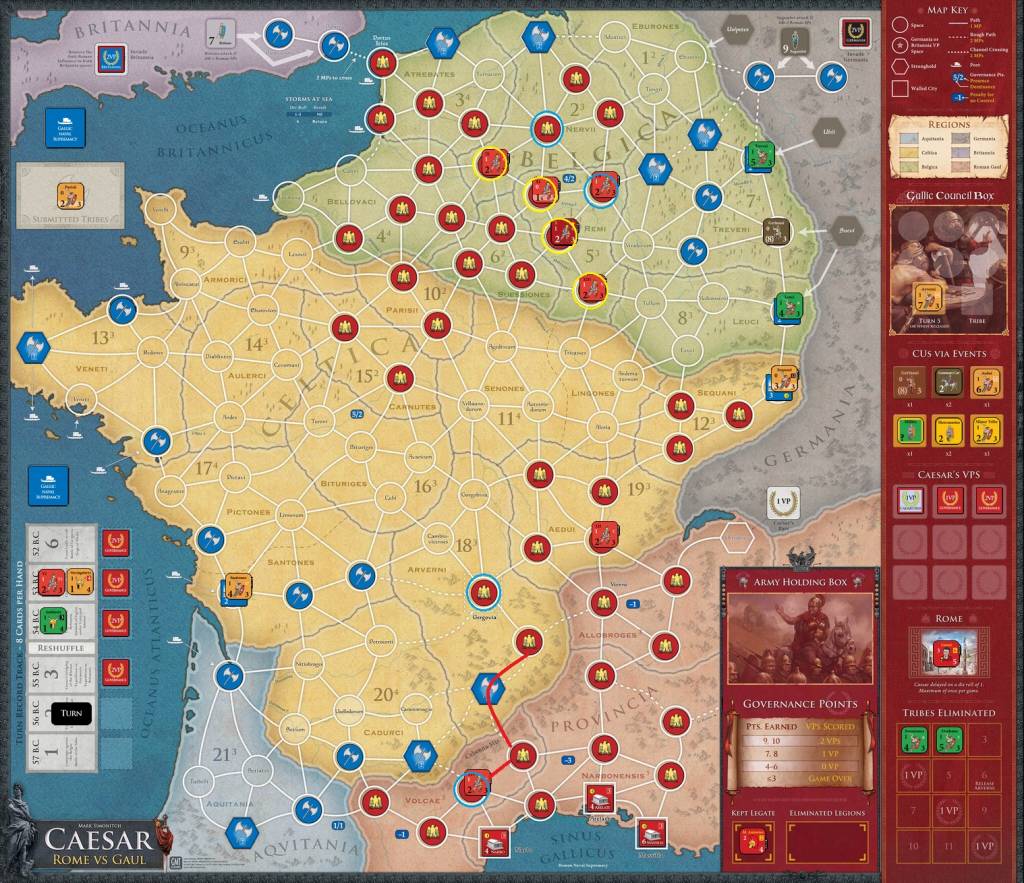
Winter
Although Romans just succeeded in governance finally, by Gallic skillful operation that aimed weak point accurately, only two tribes could be removed, and neither Britannia nor Germania could be taken. However, if Romans had advanced to Britannia, it seems that they had taken no governance VP. And Romans have superiority of IM amount, so prospect is unseen.
Turn 3, Gallic tribes rose, one in Belgica, another in Celtica, and last one hid in the Gallic council, since filled with Roman IMs. Gallics moved two tribes at the southern end of Celtica to the one space north in spring muster, and placed IMs one per each three provinces in Celtica. "This move gives a sign of "A united Gaul"." It can add one IM to each Gallic provinces where Gallic IM is located, and is the strongest card when used in middle game. Hereby it may destroy Roman IM superiority at once, however there aren't many ways to counter this.
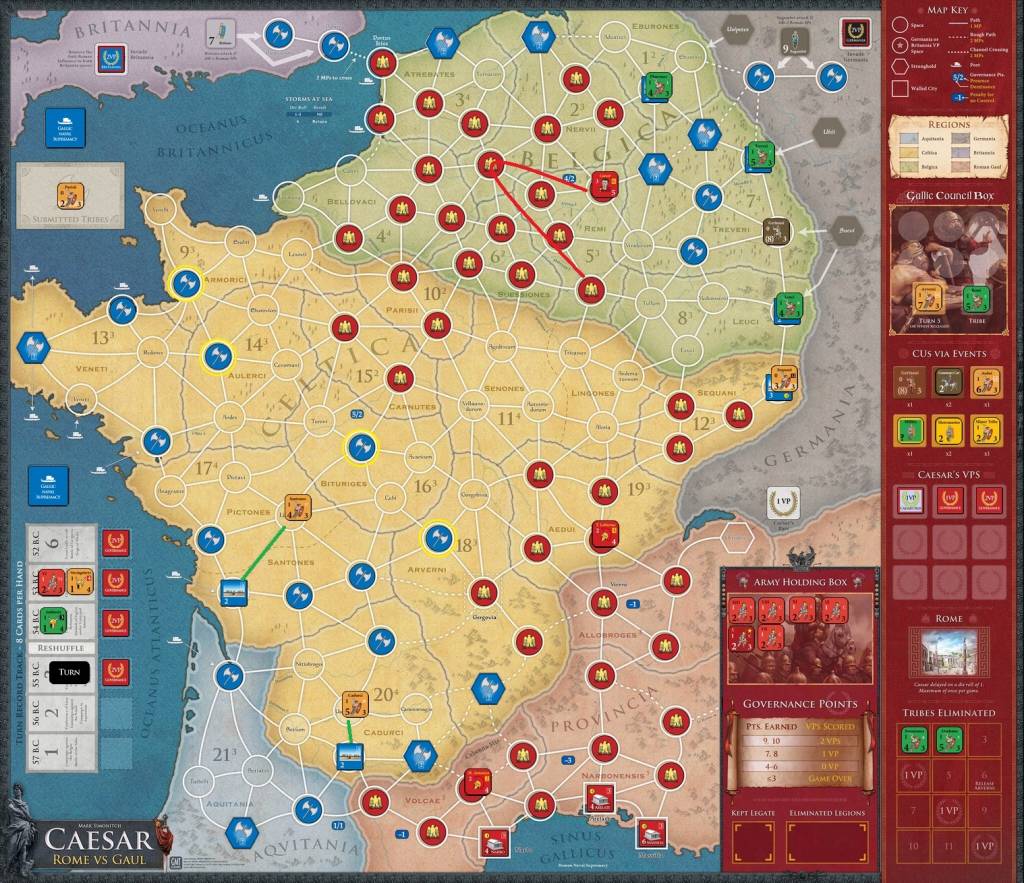
Round2
Caesar Gave up to rescue Celtica for the time being, and headed for a series of targets in front of him. He first defeated the Eburones to open the entrance, then invaded Germania using the "Roman trade", and finally defeated the exit Treveri. Meanwhile, Gallics activated "A united Gaul", which placed 9 IMs, rushed into Parisii and summoned the tribe that had submitted, and called one more tribe by "Tie of blood and marriage". Gallics did whatever they want to.
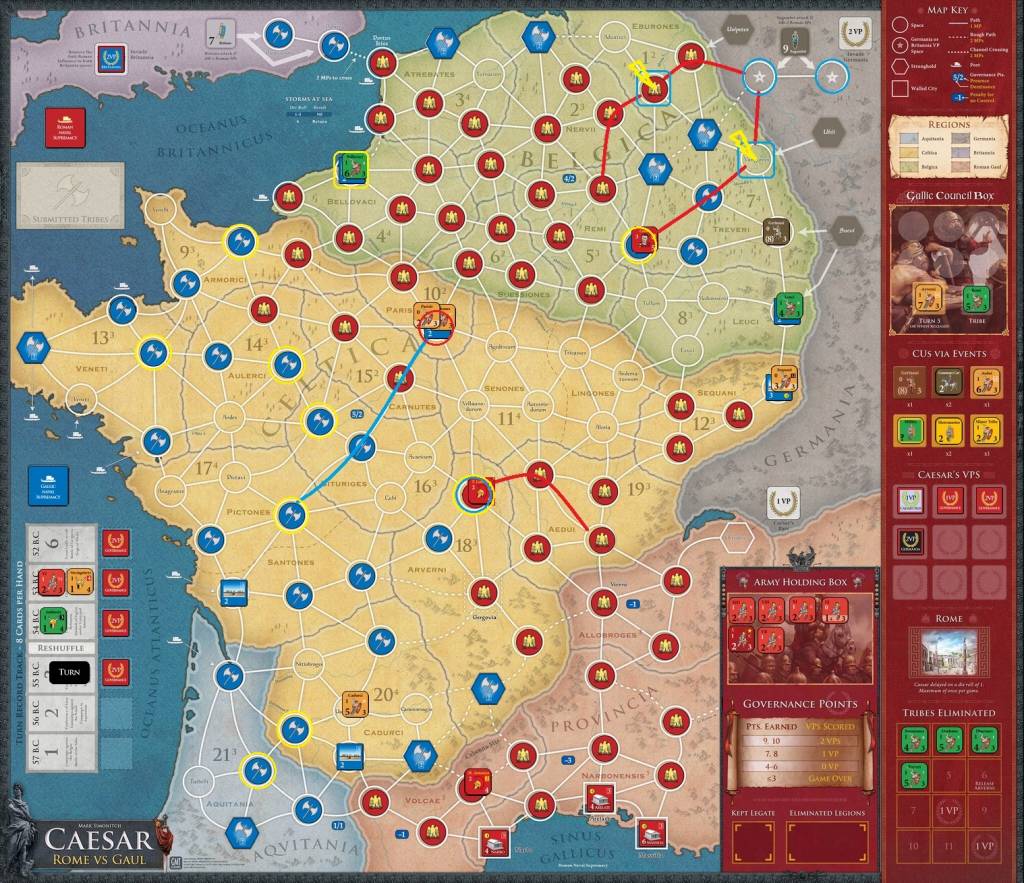
Round6
Caesar, who had finally finished his work in Germania, embarked on regaining control of Celtica from the seventh round, but the large number of IMs placed by "A united Gaul" made it impossible during this turn. After all, although Romans seized Bituriges, took only 1VP for governance by placing an IM in Aquitania. Romans divided Caesar's legions into only four parts and sent to Bituriges and Carnutes in winter, to force the Parisii to submit immediately on the next turn.
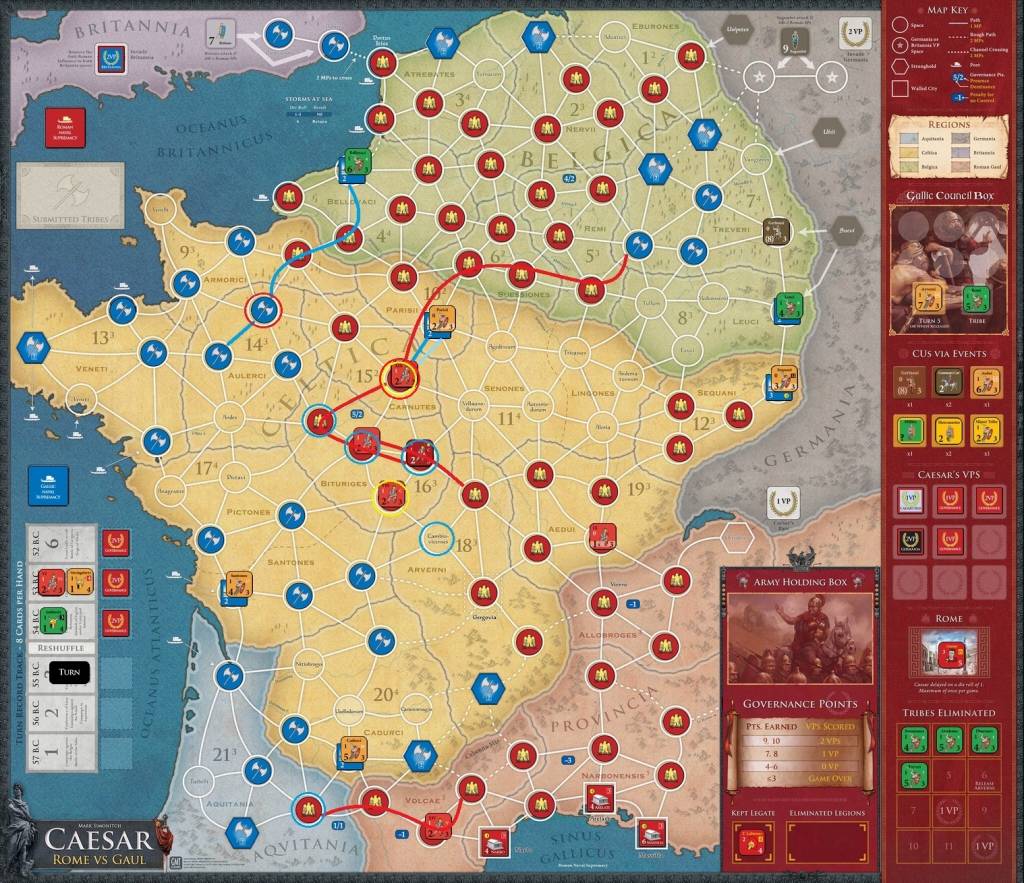
Winter
After the first half, 8VP seems enough for Romans, but Romans also have the weakness that they removed only four Gallic tribes. If Gallic player only knew the turtle strategy, it wouldn't be difficult to take 4VP in 3 turns and Romans would win easily. But William Walker was not such a Gallic player.
Turn 4, all Gallic tribes appeared in Celtica to surround the Roman army. And militias with 4 strength entered Parisii now, hereby Romans were blocked from submission they were aiming for. What should Romans do in this very difficult situation?
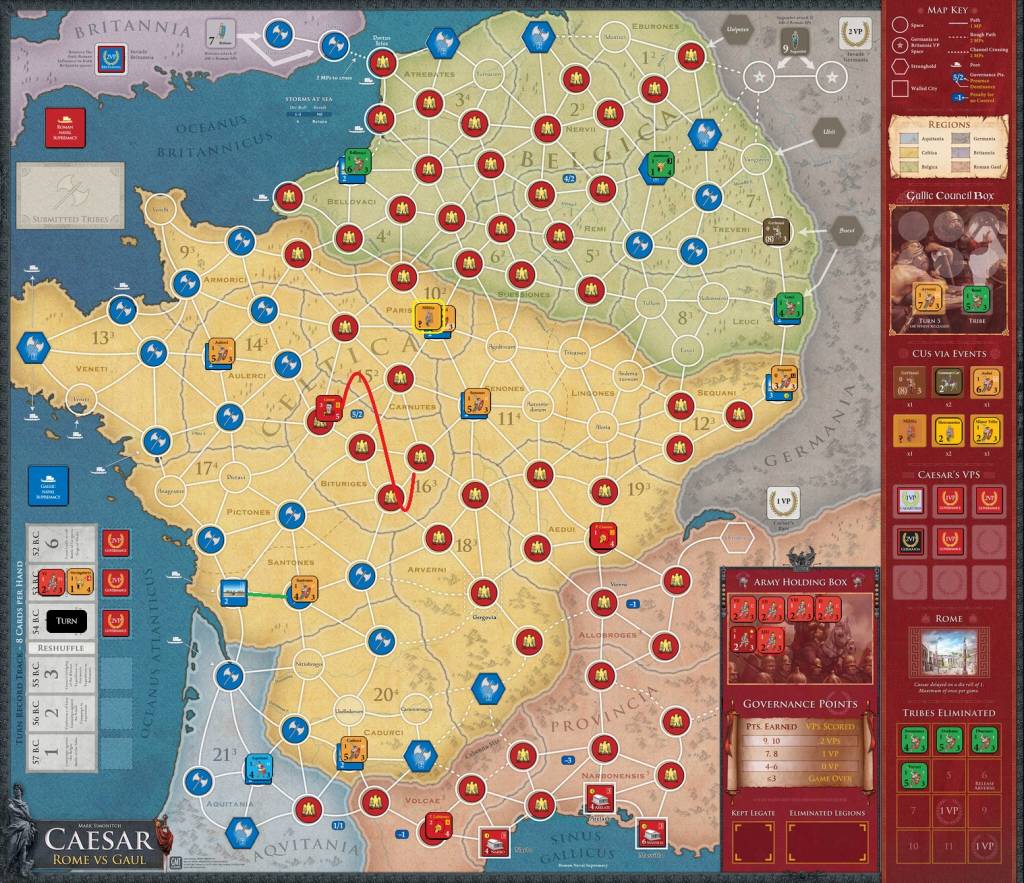
Round1
Caesar decided to postpone the Parisii capture to next year when the militia is gone, and launched a series of attacks on the rest of the Celtica tribes. First from Senones, after they fell, he returned to Bituriges, then Santones. He left a legion on the way and convert there to secure the supply line. And when it also fell, He moved to Pictones while collecting the left legion, and this time aims Aulerci. Caesar used 2MA before and after sieges to set up the continuous siege without waste.
On the other hand, Gallics also summoned the Remi with Ambiorix who appeared this turn, devastated Nervii, isolated the Roman IM at the northern end, and removed IMs in Atrebates. In addition, the Remi and Aquitani removed adjacent Roman IMs, and place 6 IMs by "Encourage the timid and convince the wavering" in conclusion. Belgica had been so strongly ruled by Romans, but it was overturned in the blink of an eye. The terrifying Gallic counterattack. The excellent Gallics change completely just by entering the leader and increasing MA by one.
Furthermore, at the moment when Santones fell, that is to say, the sixth tribe was removed and the restrictions were lifted, Gallics sent the Parisii to Gergovia and summoned the Arverni. The tight movement of Gallics does not make Romans easier at all.
However, the Gallic card that did this was "You may believe what you wish". Impossible! Do Gallics have the senate again? Romans were worried because they now have "Aid from Crassus" that can perform 5 actions. However, this time Gallics had the important purpose calling the Arverni, and they might have no other "3" card, therefore they might use this card. Or it may be bluff utilizing the previous case. And in the first place, it is unlikely that Gallics have both. And above all, Romans had the secret plan that the situation can be greatly improved in the last round, by the Crassus. Judging that this is worth the risk, Romans decided to keep the Crassus. Caesar then entered the siege of Aulerci as scheduled.
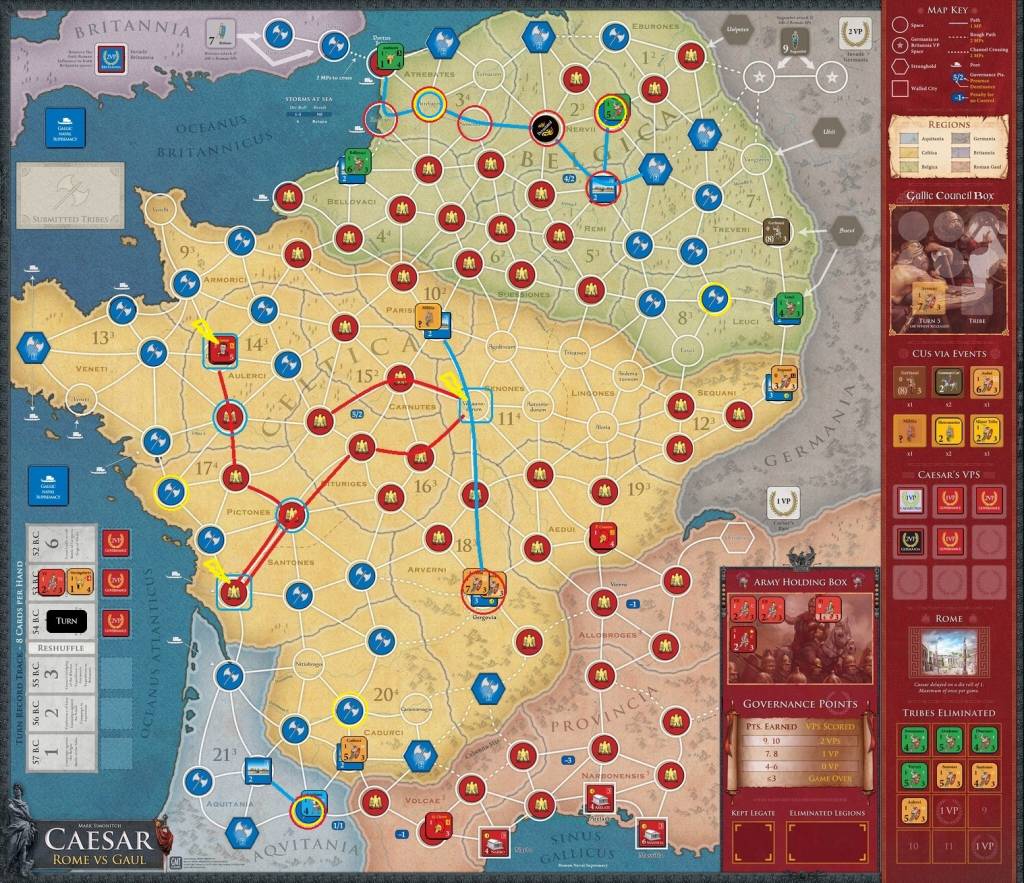
Round7
In the seventh round, Gallics returned Labienus to Rome, and Caesar continued the siege while adding the legion left on the way, then defeated the Aulerci. And what is the final Gallic card which gets attention?
"German migration"
Romans were saved. Now, the last action by the Crassus! Caesar entered Veneti from Aulerci, then converted all three Gallic IMs and filled there with Roman IMs. Thereby, yes, all 6 Gallic IMs in Pictones, Aulerci, and Armorici were removed due to isolation. The Roman operation was successful. And in order to capture Parisii with a single blow next year, Romans decided to gather all legions under Caesar's command to Carnutes in winter and placed no IM.
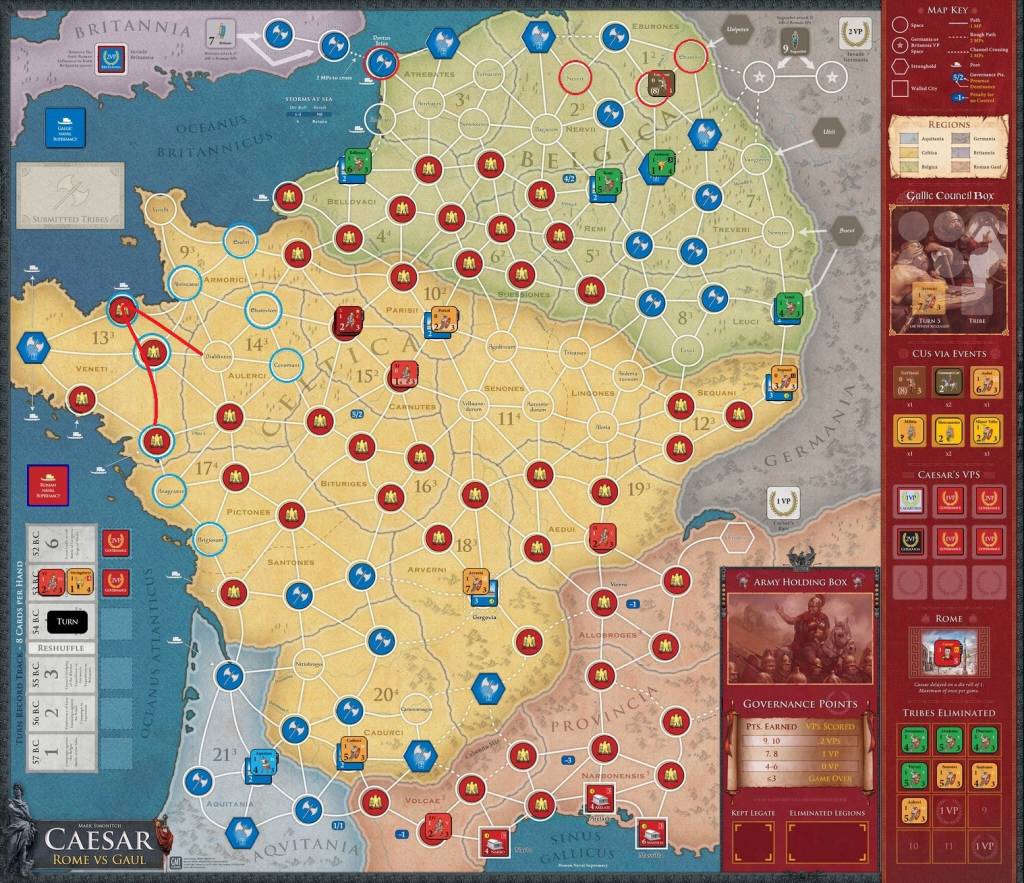
Winter
Well, Romans were beginning to imagine if this was a bit of an advantage, but this Vercingetorix can't be so sweet.
Turn 5, Gallics were well aware that if they doesn't sally out here, Romans will easily earn another 3VP. So first, Gallics summoned a mercenary to Parisii, then they invaded Volcae with the Cadurci and Aquitani led by Vercingetorix that appeared on this turn, and attacked a legion led by Crassus. Crassus avoided it, as he couldn't win against the 10-strength Vercingetorix, although he had local support and Provincia bonus.
At first, Romans were thinking optimistically about this attack, as it's enough that the land taken can be recovered later. But when they reconsidered well, they were aware that Gallics can besiege Crassus in city Narbo with 1.5 to 1. It's quite possible that Gallics have a "Stratagem & Treachery" or "Vow to Mars" not yet appeared, and Romans were in a dangerous situation losing control of Narbonensis if the city falls. Fortunately, because Romans had "Caesar's lieutenant", they recalled Labienus, and he rushed to the side of Narbo with three legions that they had placed in Aedui for capturing Sequani. "Aedui" card had been discarded previous turn, therefore no need to worry about Aedui. After that, because Romans couldn't leave Parisii anymore, Caesar started the siege. Roman schedule didn't work well, but hereby Romans are okay, surely?
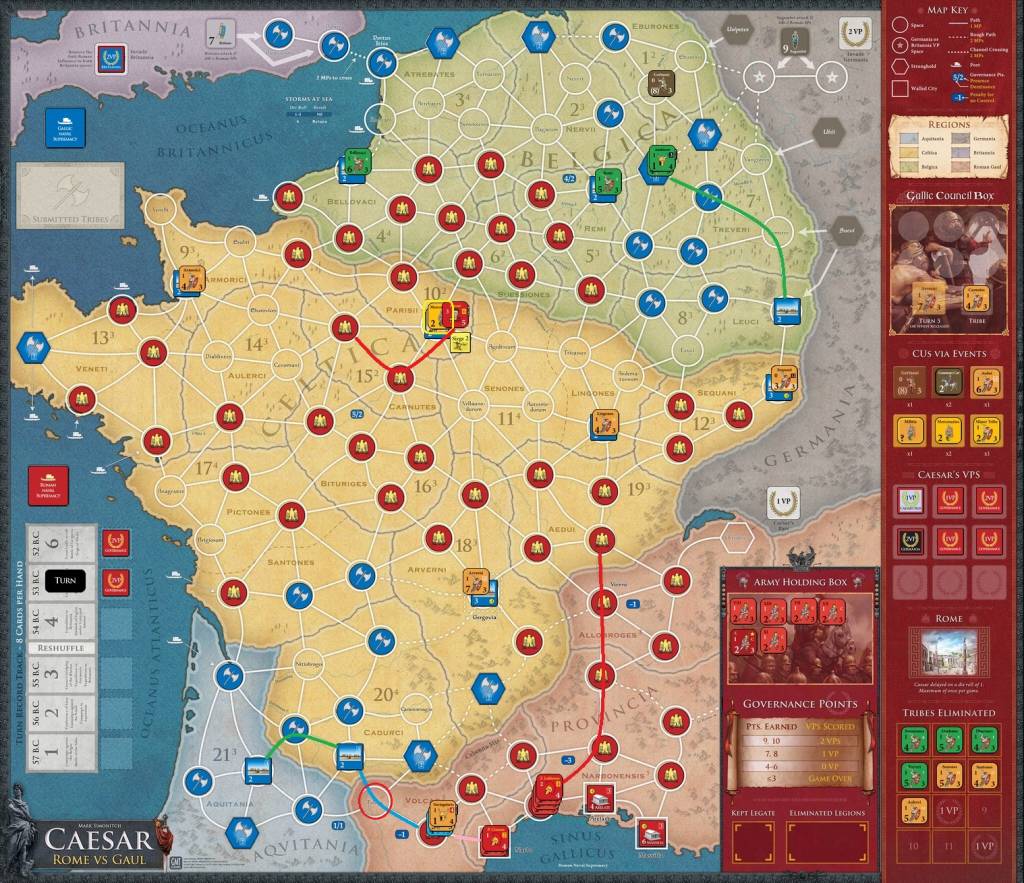
Round1
But this story was not be ended. Vercingetorix devastated two Volcae spaces and withdrew. "Oh dear! Vercingetorix could do this." Now Romans had no way to control Volcae this turn. Romans were beaten! This couldn't be helped anymore, so Caesar continued the siege of Parisii and defeated them, then he moved between the two tribes facing the Britannicus Sea.
Due to the fall of Parisii, Romans had earned 10VP, and after that, if they land on Britannia, they will reach the victory condition. There was a way to go straight to Britannia, but Caesar decided to siege the Bellovaci on the way, as Gallics could gather force and block the way home and Romans might suffer great damage.
If the Bellovaci is defeated and then Caesar advances to Britannia, Gallics will lose. Therefore, not only Ambiorix but also Vercingetorix moved toward Caesar while avoiding the Roman-controlled areas. Vercingetorix had 21 strengths, including the mighty Arverni, and it can't be known if Caesar can win when he comes. Caesar thought proceeding with the siege before enemy arrival, as a result, completed the capture.
Whereas, Vercingetorix was ready to prevent the invasion of Britannia and proceeded to Nervii. At this point, it wasn't easy for Romans to break them and land in Britannia. So Caesar headed for the fortified town in Armorici, where was not reachable from Vercingetorix, and he succeeded in a single fall. Labienus also headed for the empty Gergovia.
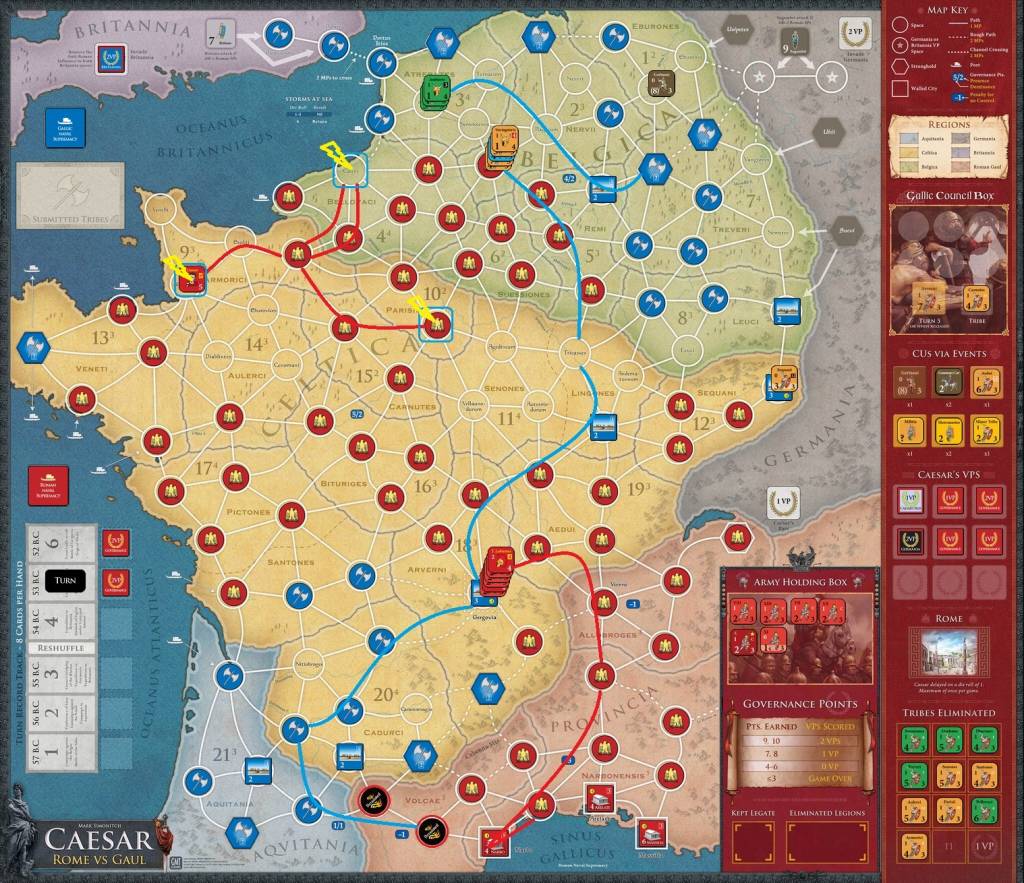
Round5
In front of Vercingetorix, who converted an IM in Nervii and waited, Caesar, who had nothing to gain even if he is confronting here, used "forced march" to advance to Aquitania at once to gain presence here, and made up the governance point lost in Volcae. Vercingetorix also headed south to Senones in response to this move, and glared at the center.
Then Caesar turned around and entered Aedui through Arverni to prevent Vercingetorix from invading key points of Romans. He left one legion each in Aquitania to prevent the event and Gergovia for the strength needed for submission. And in Gergovia, Crassus forced the Arverni to submit, and after that, sent two of those legions to Caesar. This greatly weakened the strength of Vercingetorix, which had been powerful.
And the gallic last card. Romans were wary of the Senate and left "1" card at the end, but what came out was "Constant as the Northern Star." Gallics used 3AP to send Vercingetorix alone to Carnutes, remove the IM, and call the Carnutes.
The last card of Romans was "A Friend of Rome". Caesar could also attack three tribes in Senones or the fortified town in Lingones, but the success rate was low as they could avoid or intercept adjacent to each other. Romans didn't attack these, and put the spaces adjacent to Gergovia under the influence, then ended the strategy phase. Romans placed all legions in the three adjacent spaces in Arverni and Santones for winter camp. and only one IM was placed in Gergovia.
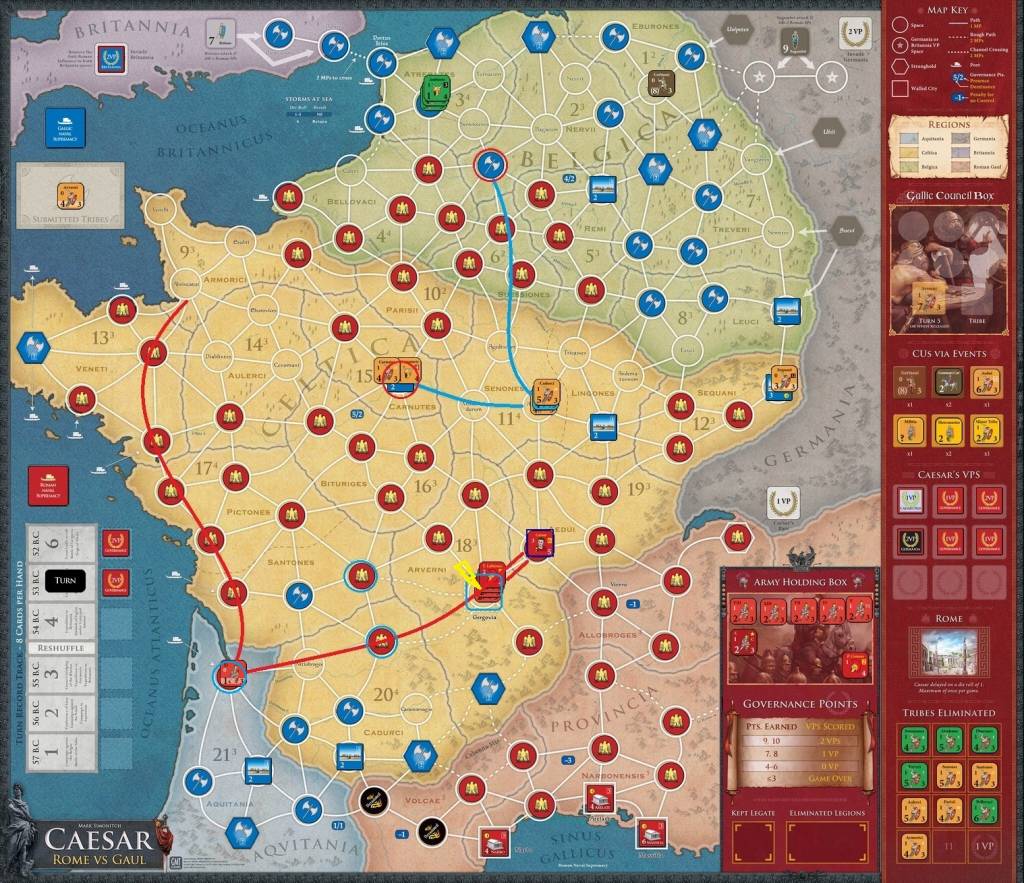
Round8
A large maneuver warfare which siege, confrontation, and long-distance movement are intricately intertwined. Battle is likely to occur but not occur, because we are reading the marginal lines of each other, and behind it is a more intense psychological warfare than direct battle. How wonderful match. And the Caesar that can be played so is also a wonderful game.
Regarding VP, it is certainly Romans approached one more step rest. However, there are many tribes at important points in Gaul as well, and if Roman governance points drop off to 3 points or less, Romans lose regardless of VP. therefore Romans must go on alerting.
Eventually, final turn, Suddenly Gallic "Senate Outraged..". Since Romans can know that Gallics almost have this, so Gallics first put it out before that Romans use good cards previously. And the card Gallics took was "Trumpets of war". It is powerful if using in combination with spring muster, but it's not so strong on the way, Romans thought at that time.
Then Gallics devastated the vacant Volcae spaces again, and Ambiorix boldly advanced to Aedui in front of Caesar. This looks dangerous if attacked by Caesar. but Ambiorix's army has two Celtica tribes next, and if they succeed in intercepting, they will have 23 strengths. It's prepared to prevent Caesar winning easily.
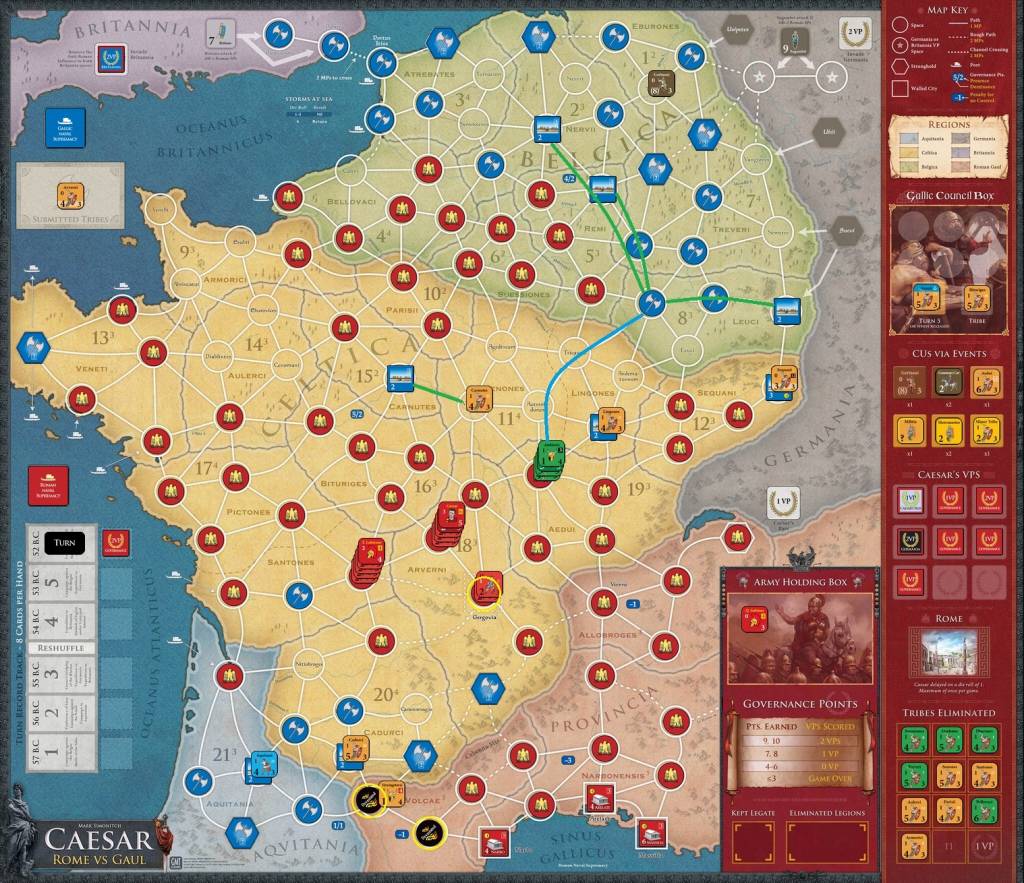
Round1
In this situation, not only that the battle is risky, but if Vercingetorix is left unattended, Provincia will be devastated, so Romans decided to head south. Caesar first proceeded to the fortified town in Cadurci, and Labienus leaved two legions on the way to supply Caesar, and then proceeds to the stronghold adjacent to Vercingetorix to prevent him from moving east.
Then, Vercingetorix escaped to the northern end of Aquitania on the other side. But Caesar handed over siege of Cadurci to Labienus, then cut off retreat route and pursued him. Vercingetorix, unable to escape, took refuge the fortified town in Aquitania. Then Caesar besieged it and took a siege point.
However, Gallics is not scared at all. After removing the siege point by stratagem, they attacked Provinceia with Ambiorix.
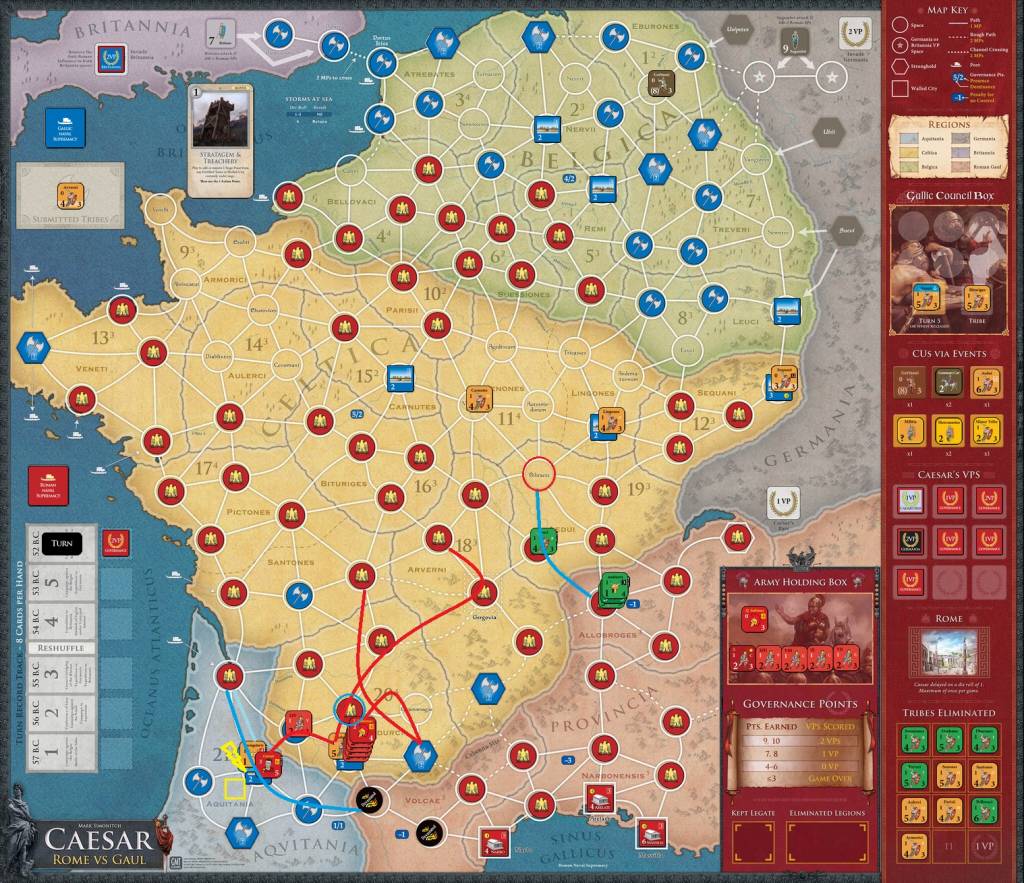
Round3
No matter what, Romans have no choice but to continue the siege. First, Caesar got 2 points and Labienus also got 1 point of siege.
Then surprisingly, Ambiorix plunged into Narbonensis without minding out of supply. He still had 13 strengths after attrition, so if Romans do nothing, Arelate can submit. It was the attack above Roman expectations.
In this crisis, Romans first tried to besiege with Caesar. And Caesar completed the siege although suffering the damage, so he took over the siege of Cadurci and Labienus rushes to rescue of Relate. Romans came this far, and if complete the siege of Cadurci, is it possible that Romans can't win?
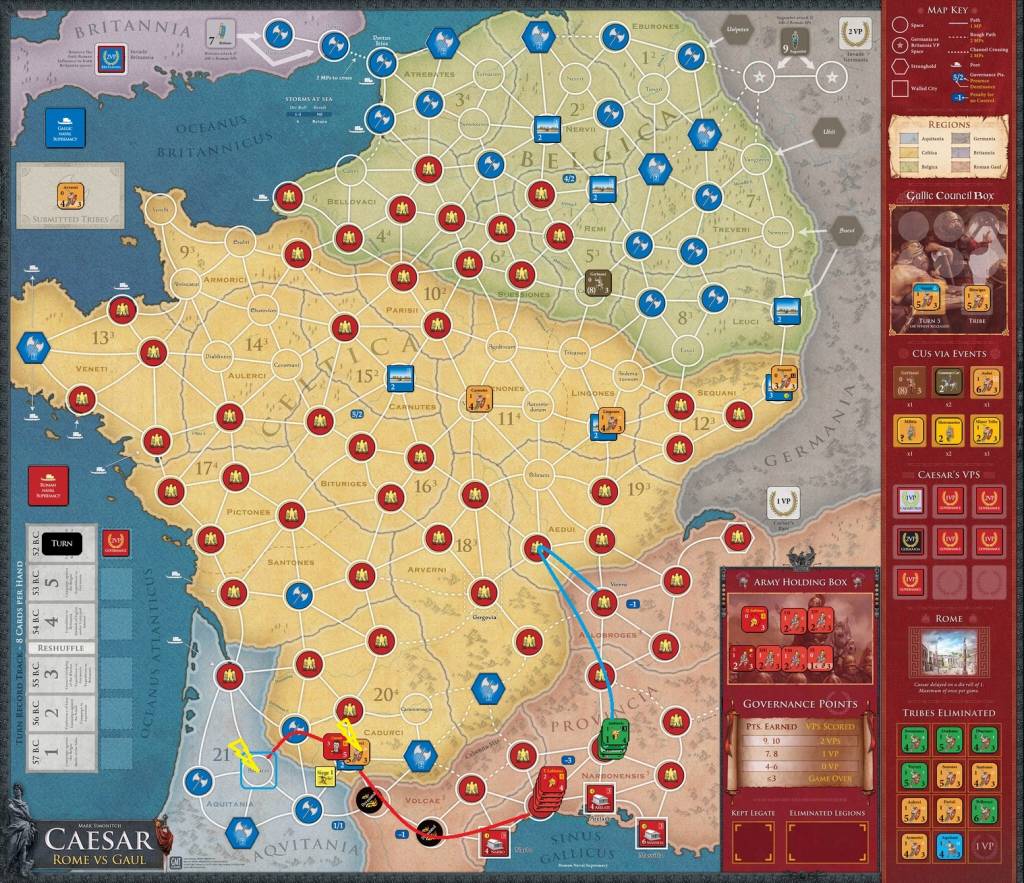
Round4
Yes, was possible. Gallics opened the long-awaited "Trumpets of war" here. Gallics rallied tribes from behind, and spread their army in Narbonensis, hereby broke Roman control and avoided out-of-supply attrition.
Continuation of the unexpected. How useful the trumpets! By this loss of Roman Narbonensis control, Romans will lose if they can't drive Gallic army out. Certainly, the Gallic army isn't enough to defeat the entire Roman army. But this is the only operation that Gallics can be win here. In this situation, which an ordinary person would have resign, the creativity to devise it is wonderful.
If Romans attack with Labienus' army alone in a hurry, the Gallic army will be integrated by interception and the chances of winning will not be sufficient. To ensure win, Romans waited for Caesar to finish the siege and rush to reinforcement.
Meanwhile, Gallics also gathered the rest of the tribes and were ready for the final battle. Caesar consolidated Labienus' army and plunged into Gallic army. Only one of tribes, which is not reduced, succeeded in intercepting and Gallic army had 15 strengths. Romans had 21 strengths including the Provincia bonus. The struggle of the Gallic army do not reach Caesar's abilities, and Romans won this battle.
The situation would have been far more dangerous for Romans, if they had not forced the Arverni to submit at previous turn. And it was possible since it was able to attract Vercingetorix in the direction of Britannia, which is due to the fact that Romans prioritized control of Gaul instead of Britannia in front of them on the second turn. What a deep game it is!
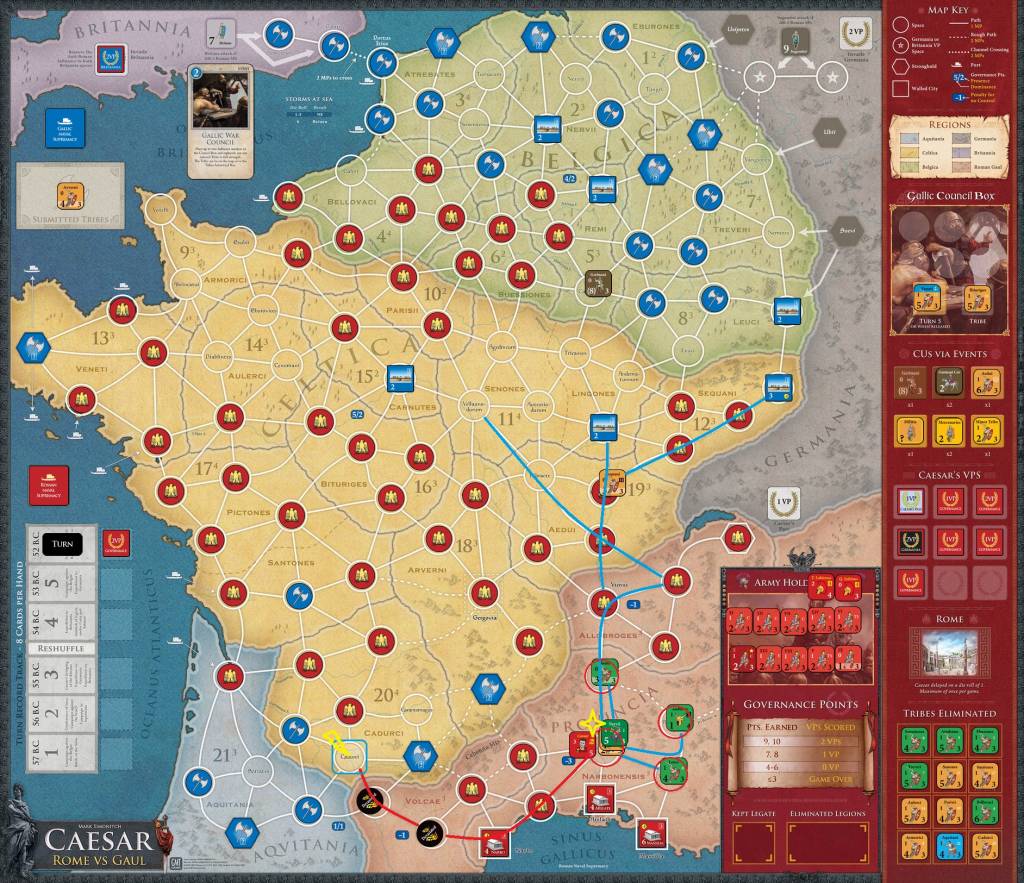
Round6
Finally, Romans defeated all the invading Gallic tribes, and the long and long game was over.
First of all, William Walker is a very strong player, and it was the brilliant play that I couldn't lose my concentration even with a single move. I've played a lot, but I've never been so nervous. In particular, the invasion of Provincia was awesome, and I sank into thought about how to deal with it.
And this game is really well-balanced, both are able to take various measures, and there are many and deep thoughts. And it was confirmed that this game is definitely the best masterpiece. There is no other beautiful game that changes seamlessly from the early stage of the Fuseki(influence race), via the middle stage of the guerrilla warfare, and toward the final stage of the decisive battle between mainstays.
You have read this far, looked at examples, read more strategic research if necessary, and still do you think Romans can't win? Do you think Gallics is bored?
Absolutely not! Gallics is barely even with such strong and much actions. If Gallics only use the turtle strategy, Romans can easily win. And for Gallics to win, they have to think of complex and diverse strategies that are far from a bore.
If Romans were competing for IMs in the same way as Gallics, the numbers on the cards are the same, and Gallics have many events, which many IMs can be placed, therefore, it was a matter of course that Romans cannot win. Romans must use Caesar's mobility to remove, convert, and isolate Gallic IMs, and place many IMs in winter to overturn the matter. And in the first half game, Romans should combine it with siege and quest efficiently. If Romans does it properly, Gallics can not win mostly in the IM number competition. It means the turtle strategy collapsed.
It is absolutely impossible to change the balance of this completed game to Roman favor. Add 1VP to Romans? Romans win 100%. Add IMs to Romans? Look at images above again. How greedy although the number of IMs is always so dominant. Strengthen Roman legions? Gallics lose motivation to fight the Roman army and will not be able to play an interesting game like this match at all.
To designers, be constant as the northern star, and you may believe what you designed and developed.
To players, This game is best now. Please enjoy the best game as best without change.
To index


















